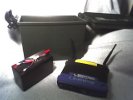|
HSMM-MESH™ is not just any mesh network, it is a specific mesh network designed to meet certain goals and operate in a specific fashion. It will not meet the needs of everyone and is not suitable for every purpose. However, it is quite flexible and should provide a valuable and extensible service for its users.
HSMM-MESH™ is meant to be the high speed digital progression of existing Amateur Radio practices and used only by licensed Amateur Radio operators. Emergency communication is very much a driving factor in the architecture of the network. To that end, it aims to be the network of choice when the need arises to quickly create a network where none exists, and to be the easiest to set up and most capable while running. It also is suitable for permanent installation, providing high speed digital Amateur Radio communications over a region with line-of-sight RF access to at least one of the participating nodes.
So with that in mind, here are some of the features that define HSMM-MESH™:
- All networks called HSMM-MESH are interoperable
- A node configured to participate in one region can be moved to another region and continue to operate, without reconfiguration, with full access to the network
- Experimentation is encouraged, but if a network is set up in which a standard node would not have full network access, its SSID must be changed to something other than HSMM-MESH to indicate that it is an alternate network
- The OLSR protocol is used to route traffic between all nodes that can see at least one other node, thereby forming a mesh network and allowing all nodes to communicate with each other if a path exists between them
- The WiFi interface operates in Ad-Hoc mode, otherwise peer-to-peer communication would not be possible
- A node should require a minimum amount of configuration before becoming fully operational
- General participation in the mesh should not require any centralized administration
- No allocation of resources or manual assignment of addresses or subnets is necessary
- exceptions for specific cases include but are not limited to:
- inter-mesh or inter-region bridges
- any services which can cause network conflicts
- Access to the mesh is available only from a mesh node, not directly to client devices
- Equipment on the LAN of a mesh node should not require any special software or setup to gain full access to the mesh
- The supplied DHCP parameters (or their static equivalent) should be sufficient for full network connectivity
- This does not pertain to specific applications, only to general network access
- It is a fully self-sufficient network and does not require any other infrastructure or resources to be in place for its participating nodes to be able to communicate with each other
- DNS is an integral part of the system - you should never have to know the IP address of any mesh node, using the hostname is sufficient to initiate a connection
Additionally, there are certain things that HSMM-MESH™ is not:
- it is NOT a replacement for your home internet connection
- being an Amateur Radio network, it can only carry traffic that is allowed under FCC Part 97 rules
- several types of internet traffic violate these rules
- also, it is NOT a replacement for your home internet connection
- finally, it is N O T a replacement for your home internet connection
- and by the way, it most certainly CANNOT be used in any way with your business network
I hope I have made myself clear. If the internet traffic contains data types that are already being used over ham radio such as Echolink or findu.com, that is perfectly acceptable. I am not a lawyer so I will not attempt to enumerate all the types of data that are or are not permissible under Part 97. It is your responsibility to comply with the terms of your license. If you question the permissibility of your internet traffic, it is probably best to not use it. This is the kind of traffic that your home internet connection is better suited for. You probably have Part 15 WiFi access to the internet. Use that instead.
Section 97.113.a.5 states: No amateur station shall transmit communications, on a regular basis, which could reasonably be furnished alternatively through other radio services.
This is what Part 15 is for: your day-to-day non-ham internet activity. HSMM-MESH™ on the other hand is, as are all ham radio activites, a service for the purpose of self-training, intercommunication and technical investigations carried out by amateurs, that is, duly authorized persons interested in radio technique solely with a personal aim and without pecuniary interest.
|



